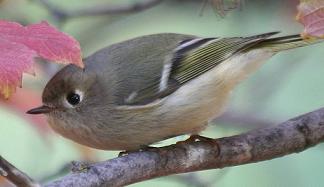Kinglet
Identification and Pictures
 Kinglets are tiny birds 4 to 4 1/2
inches; they are one of the
smallest in America. They are constantly moving, and flicking their wings, making them difficult to see as they flit from place to place. Ruby-crowned
kinglets and the Golden-crowned kinglets are the two that are seen in North America. Kinglets are tiny birds 4 to 4 1/2
inches; they are one of the
smallest in America. They are constantly moving, and flicking their wings, making them difficult to see as they flit from place to place. Ruby-crowned
kinglets and the Golden-crowned kinglets are the two that are seen in North America.
Ruby-crowned Kinglet (Regulus calendula)
Ruby-crowned
kinglets are olive above, and white below. One of the most striking features of this bird is the broken white eye-ring which gives it the appearance of large eyes. The wings have two white bars. The Primary and secondary flight feathers are dark.
Wings and tail feathers have a yellow leading edge so flashes of yellow are seen on flight.
The adult male has a bright ruby red crown patch which is usually hidden.
The red patch is displayed when the bird is excited. Photos
by Keith Lee. The camera I use is the Canon
EOS 40D. Visit All-birds store
Golden-crowned Kinglet (Regulus satrapa) 301/4 to 4 inches Golden-crowned kinglets are also olive-gray birds.
The Golden-crowned kinglets have a bold black, and white striped facial pattern and gold crown patch.
The crown patch is yellow in females, and orange to red in males.
The adults always show the crown patch with a black border, and
have a white stripe over the eyes.
Sound of Kinglet
Ruby-crowned
kinglet's call
is a single quick di-dit. The song is 3 to 4 high notes followed by several low notes, and a chant like (tee tee tee tew tew tew tedatee tedadee tedadee).
Golden-crowned Kinglets call note is single see see see.
The song is a series of high thin notes like the call, which drop down into a chatter
Golden-crowned Kinglet: Click for Sound
Preferred Habitat
Kinglets like conifer forests. Both Ruby, and Golden crowned
kinglets will join flocks of other birds for feeding. In winter they can be found in other woodlands and forests.
Breeding and Nesting
Kinglets form new pairs each year for mating.
Females build the nests, which are usually in conifers. The nest is usually well hidden. It is a deep nest of grass, lichen, bark strips, twigs, rootlets, needles.
Spider webs comprise the outer walls, and feathers, plant down, and hair form a soft lining.
Eggs
Females incubate 7 to 12 whitish eggs with brown and gray
spots, for about 2 weeks. The male will bring her food while she sits on the nest.
Both parents will feed the young, which will leave the nest in about 15 days.
The females may leave the breeding territory but the male will
continue to feed the young birds for 10 or so days.
Food and Feeding
Kinglets like to eat small insects. They will often feed in groups of birds such as
nuthatches, chickadees,
titmice and others. They are always on the move with quick playful movements, hopping about in the branches of trees and bushes in forests or even in backyards.
For more on food
and feeding click here.
For more on feeders click here.
To learn about other favorite
birds click here.

|
